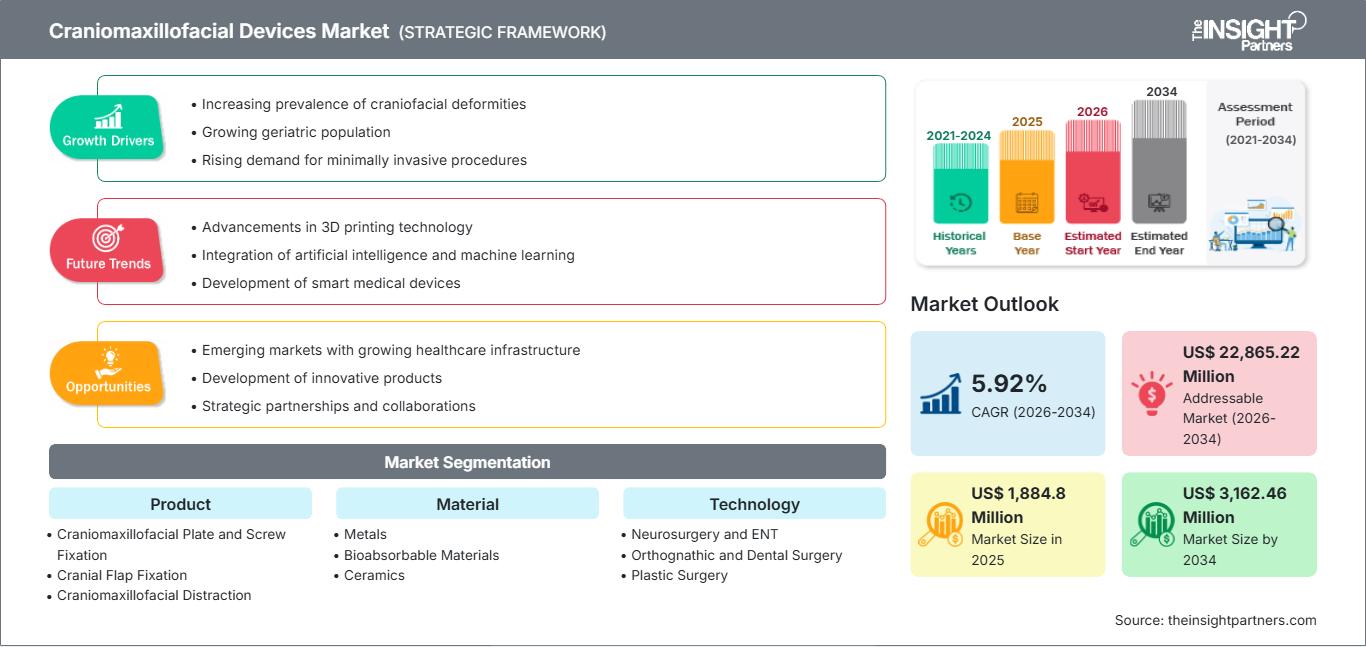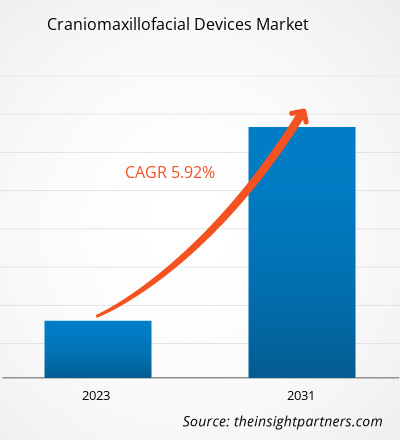Le marché des dispositifs cranio-maxillo-faciaux, évalué à 1 884,8 millions de dollars américains en 2025, devrait atteindre 3 162,46 millions de dollars américains d’ici 2034, soit une croissance annuelle composée de 5,92 % sur la période 2026-2034. L’évolution constante du marché offre de nouvelles opportunités aux acteurs du secteur. Le paysage global témoigne d’une progression stable et d’un fort potentiel de croissance à long terme.
Les principaux facteurs de croissance du marché des dispositifs cranio-maxillo-faciaux sont la demande croissante de procédures mini-invasives, les progrès des technologies d'impression 3D et d'imagerie, ainsi que l'augmentation mondiale du nombre de cas de traumatismes graves et de fractures faciales. Les avancées technologiques en impression 3D et en imagerie permettent aux fabricants de proposer des solutions personnalisées. Outre ces avancées, l'amélioration des résultats pour les patients stimule la croissance de ce marché. Parmi les tendances actuelles, on observe l'utilisation d'implants en matériaux biorésorbables afin de minimiser les complications à long terme.
Facteurs de croissance et défis :
Le besoin de procédures chirurgicales reconstructives efficaces et l'augmentation du nombre d'accidents de la route liés à l'urbanisation et à l'industrialisation devraient stimuler le marché des dispositifs cranio-maxillo-faciaux. Par exemple, les fractures mandibulaires peuvent avoir diverses causes, notamment les agressions, les traumatismes sportifs et les accidents de la route, comme l'indique l'article « Prévalence et caractéristiques des fractures mandibulaires : une étude rétrospective en Inde », publié en 2022. Les techniques mini-invasives ont révolutionné la chirurgie cranio-maxillo-faciale, offrant aux patients des avantages tels que des cicatrices réduites, des temps de récupération plus courts et un risque de complications moindre par rapport aux chirurgies ouvertes traditionnelles. L'adoption croissante des procédures mini-invasives engendre une demande accrue de dispositifs spécialisés. Les dispositifs cranio-maxillo-faciaux, tels que les distracteurs, les plaques, les vis et les implants, font l'objet d'innovations constantes afin de répondre aux exigences spécifiques des chirurgies mini-invasives, permettant ainsi aux chirurgiens de réaliser des interventions complexes avec précision et efficacité. De plus, les progrès de l'impression 3D permettent la production d'un grand nombre d'implants personnalisés et performants, d'une grande précision. À mesure que les professionnels de santé reconnaissent les avantages des interventions mini-invasives en termes d'amélioration des résultats et de la satisfaction des patients, la demande en dispositifs cranio-maxillo-faciaux innovants, adaptés à ces techniques, devrait continuer de croître dans les années à venir.
La pénurie de professionnels qualifiés maîtrisant les techniques chirurgicales avancées freine la croissance et le développement du marché, les établissements de santé peinant à répondre à la demande croissante d'interventions complexes. Combler ce fossé entre l'offre et la demande par des programmes de formation et des initiatives pédagogiques sera probablement essentiel pour exploiter pleinement le potentiel du marché des dispositifs cranio-maxillo-faciaux et améliorer la prise en charge des patients.
Personnalisez ce rapport selon vos besoins.
Vous bénéficierez d'une personnalisation gratuite de tous les rapports, y compris certaines parties de ce rapport, l'analyse par pays, le pack de données Excel, et vous profiterez également d'offres et de réductions exceptionnelles pour les start-ups et les universités.
Marché des dispositifs cranio-maxillo-faciaux : Perspectives stratégiques

-
Découvrez les principales tendances du marché présentées dans ce rapport.Cet échantillon GRATUIT comprendra une analyse de données, allant des tendances du marché aux estimations et prévisions.
Segmentation et portée du rapport :
L'analyse du marché des dispositifs cranio-maxillo-faciaux a été réalisée en considérant les segments suivants : produit, matériau et application. Géographiquement, le marché est segmenté en Amérique du Nord (États-Unis, Canada et Mexique), Europe (Royaume-Uni, Allemagne, France, Italie, Espagne et reste de l'Europe), Asie-Pacifique (Chine, Japon, Inde, Australie, Corée du Sud et reste de l'Asie-Pacifique), Moyen-Orient et Afrique (Émirats arabes unis, Arabie saoudite, Afrique du Sud et reste du Moyen-Orient et de l'Afrique) et Amérique du Sud et centrale (Brésil, Argentine et reste de l'Amérique du Sud et centrale).
Analyse segmentaire :
Informations basées sur les produits
Selon le type de produit, le marché est segmenté en fixation cranio-maxillo-faciale par plaques et vis, fixation par lambeau crânien, distraction cranio-maxillo-faciale, remplacement de l'articulation temporo-mandibulaire, fixation thoracique et substituts de greffe osseuse. Le segment de la fixation cranio-maxillo-faciale par plaques et vis détenait la plus grande part de marché des dispositifs cranio-maxillo-faciaux en 2023. Il devrait enregistrer le taux de croissance annuel composé (TCAC) le plus élevé entre 2023 et 2031.
Perspectives basées sur les matériaux
Le marché des dispositifs cranio-maxillo-faciaux est segmenté, selon le matériau utilisé, en métaux, matériaux bioabsorbables et céramiques. Le segment des métaux devrait détenir une part importante du marché d'ici 2031.
Informations basées sur les applications
Selon l'application, le marché se divise en neurochirurgie et ORL, chirurgie orthognathique et dentaire, et chirurgie plastique. Le segment de la chirurgie orthognathique et dentaire devrait détenir une part importante d'ici 2031.
Dispositifs cranio-maxillo-faciaux
Aperçu régional du marché des dispositifs cranio-maxillo-faciaux
Les tendances régionales et les facteurs influençant le marché des dispositifs cranio-maxillo-faciaux tout au long de la période prévisionnelle ont été analysés en détail par les analystes de The Insight Partners. Cette section aborde également les segments de marché et la répartition géographique du marché des dispositifs cranio-maxillo-faciaux en Amérique du Nord, en Europe, en Asie-Pacifique, au Moyen-Orient et en Afrique, ainsi qu'en Amérique du Sud et centrale.
Portée du rapport sur le marché des dispositifs cranio-maxillo-faciaux
| Attribut du rapport | Détails |
|---|---|
| Taille du marché en 2025 | 1 884,8 millions de dollars américains |
| Taille du marché d'ici 2034 | 3 162,46 millions de dollars américains |
| TCAC mondial (2026 - 2034) | 5,92% |
| Données historiques | 2021-2024 |
| Période de prévision | 2026-2034 |
| Segments couverts |
Sous-produit
|
| Régions et pays couverts |
Amérique du Nord
|
| Leaders du marché et profils d'entreprises clés |
|
Densité des acteurs du marché des dispositifs cranio-maxillo-faciaux : comprendre son impact sur la dynamique commerciale
Le marché des dispositifs cranio-maxillo-faciaux connaît une croissance rapide, portée par une demande croissante des utilisateurs finaux. Cette demande est alimentée par l'évolution des préférences des consommateurs, les progrès technologiques et une meilleure connaissance des avantages de ces produits. Face à cette demande grandissante, les entreprises diversifient leur offre, innovent pour répondre aux besoins des consommateurs et tirent parti des tendances émergentes, ce qui contribue à stimuler la croissance du marché.

- Obtenez un aperçu des principaux acteurs du marché des dispositifs cranio-maxillo-faciaux.
Analyse régionale :
Le rapport sur le marché des dispositifs cranio-maxillo-faciaux couvre l'Amérique du Nord, l'Europe, l'Asie-Pacifique, le Moyen-Orient et l'Afrique, ainsi que l'Amérique du Sud et centrale. L'Amérique du Nord détenait la plus grande part de marché en 2023 et devrait conserver sa position dominante (en termes de part de marché) durant la période de prévision. Les États-Unis représentent la plus grande part du marché nord-américain et mondial. La croissance du marché dans ce pays est attribuée à une forte pratique sportive, à une augmentation du nombre de fractures faciales et à la présence d'un grand nombre d'athlètes internationaux résidant aux États-Unis. Par ailleurs, la demande croissante de procédures mini-invasives devrait également stimuler le marché américain.
Grâce à son système de santé très performant, les États-Unis attirent l'attention des grandes multinationales désireuses d'accroître leur part de marché. Par ailleurs, le nombre d'interventions chirurgicales pratiquées aux États-Unis augmente chaque année, ce qui profite au marché étudié. L'Académie américaine des chirurgiens cranio-maxillo-faciaux présente les dernières avancées et les spécificités de la recherche en chirurgie cranio-maxillo-faciale. L'avenir de la neurochirurgie fœtale in utero et d'autres techniques chirurgicales a été examiné lors de la réunion annuelle de 2021.
Paysage concurrentiel et entreprises clés :
Les prévisions du marché des dispositifs cranio-maxillo-faciaux présentées dans ce rapport peuvent aider les acteurs de ce marché à élaborer leurs stratégies de croissance. DePuy Synthes (J&J), Stryker, Medtronic, B. Braun Melsungen AG, Reni Shaw plc., Medartis AG, KLS Martin Group, Xilloc Medical B.V., Synimed et Zimmer-Biomet figurent parmi les entreprises clés analysées dans ce rapport. Ces sociétés s'attachent à élargir leur offre afin de répondre à la demande croissante des consommateurs à travers le monde. Leur présence internationale leur permet de servir une clientèle nombreuse et, par conséquent, d'accroître leur part de marché.
- Analyse historique (2 ans), année de base, prévision (7 ans) avec TCAC
- Analyse PEST et SWOT
- Taille du marché Valeur / Volume - Mondial, Régional, Pays
- Industrie et paysage concurrentiel
- Ensemble de données Excel
Rapports récents
Rapports connexes
Témoignages
Raison d'acheter
- Prise de décision éclairée
- Compréhension de la dynamique du marché
- Analyse concurrentielle
- Connaissances clients
- Prévisions de marché
- Atténuation des risques
- Planification stratégique
- Justification des investissements
- Identification des marchés émergents
- Amélioration des stratégies marketing
- Amélioration de l'efficacité opérationnelle
- Alignement sur les tendances réglementaires






















 Obtenez un échantillon gratuit pour - Marché des dispositifs craniomaxillo-faciaux
Obtenez un échantillon gratuit pour - Marché des dispositifs craniomaxillo-faciaux